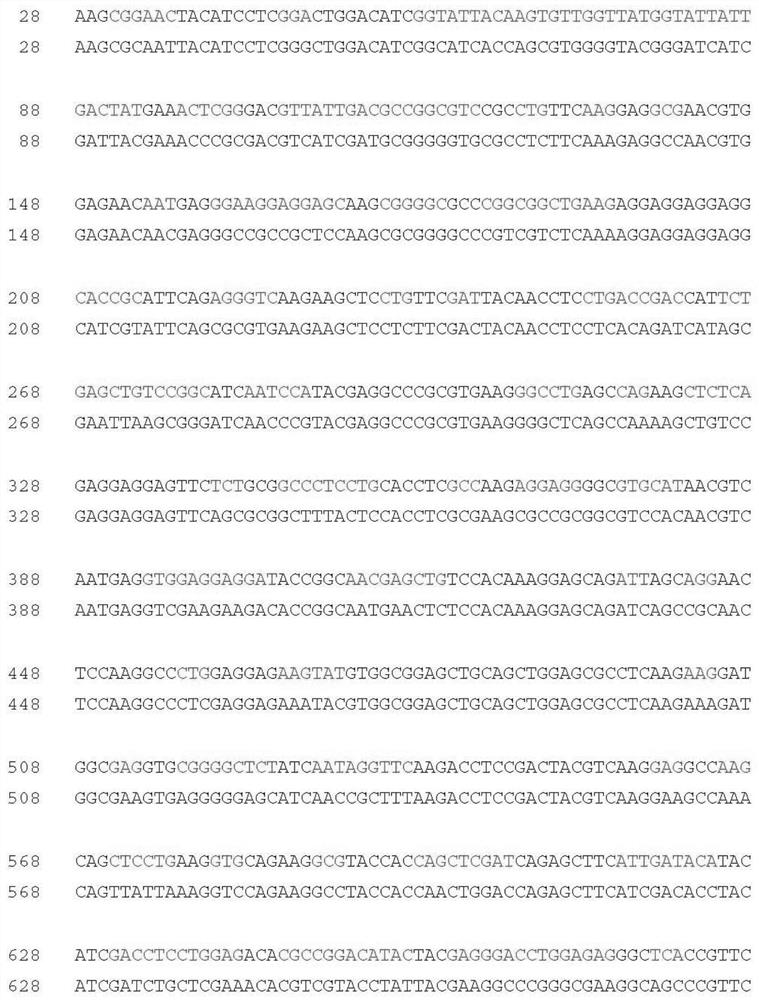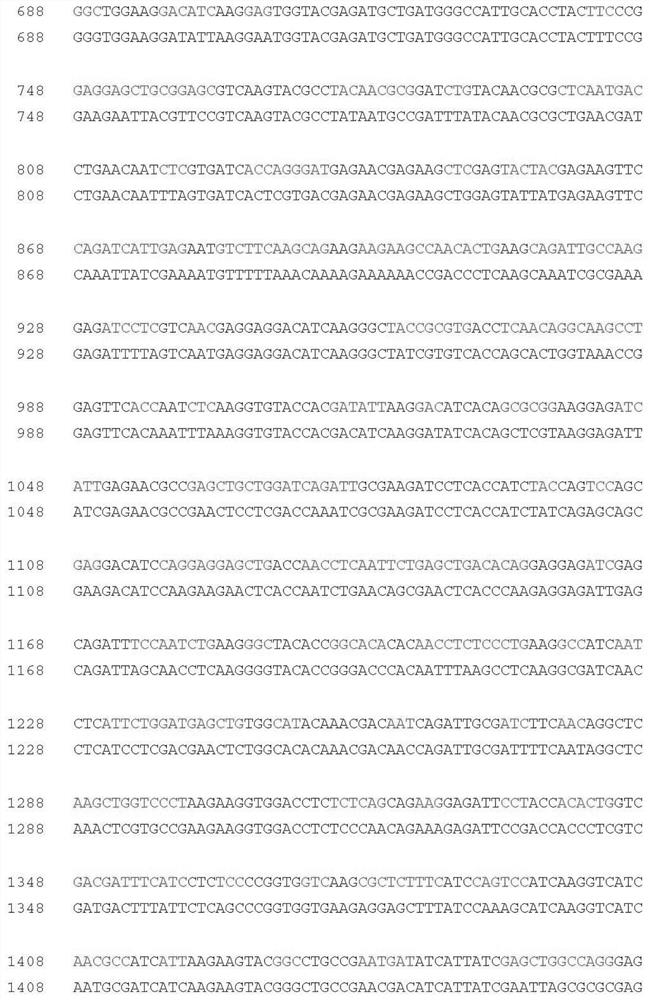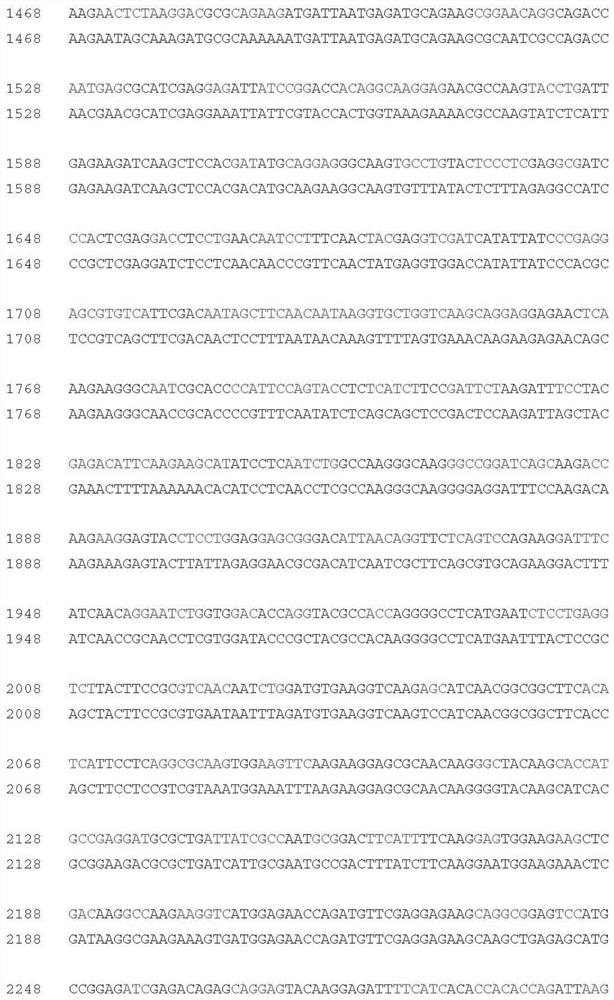A high editing efficiency SaCas9 gene and its application
An editing and gene technology, applied in the fields of biotechnology and plant genetic engineering, can solve problems affecting the efficiency of DNA double-strand cutting, safety concerns, and low expression efficiency
- Summary
- Abstract
- Description
- Claims
- Application Information
AI Technical Summary
Problems solved by technology
Method used
Image
Examples
Embodiment 1
[0041] Example 1 - SaCas9 Gene
[0042] The gene of the present application is named plantSaCas9, and its sequence is shown in SEQ ID NO: 1. For comparison with the SaCas9 sequence, see Figure 1-5 .
[0043] Further analyze its base composition, analyze the protein amino acid sequence encoded by the plant SaCas9 of the present invention and the existing SaCas9 gene, and the amino acid sequence of the two is completely consistent.
[0044] After the designed plantSaCas9 gene was sent to Suzhou Jinweizhi Biotechnology Co., Ltd. for synthesis, it was connected to the PUC57-AMP vector to form the PUC57-AMP-plant SaCas9 vector, and loaded into E. coli XL-blue strain.
Embodiment 2
[0045] Embodiment 2—contain the construction of plant targeting vector of plant SaCas9 gene
[0046]From Escherichia coli XL-blue containing the PUC57-AMP-plant SaCas9 vector, use the Axygen plasmid extraction kit to extract the plasmid, digest it with NotI / SacI, and recover the plantSaCas9 fragment. At the same time, NotI / SacI enzymes were used to linearize pHUN900, and pHUN600 was recovered, and the above-mentioned plantSaCas9 fragment and pHUN900 fragment were connected with T4 ligase (purchased from TaKaRa Company) to obtain the plant expression vector pHUN900-plant SaCas9 ( Figure 6 ), named as pHUN911.
[0047] Selection of the nucleotide sequence AAACCCATATTGCTTGAGGCA at position 573-599 in the rice OsPDS gene (Os03g0184000) AGGGAT , (the underlined part is the PAM sequence of the 5'NNGRRT-3' structure), as the targeting site. The target site sequence was fused to pHUN911 to form pHUN911-PDS. The plant expression vector was transformed into Agrobacterium tumefacien...
Embodiment 3
[0048] Example 3—the genetic transformation of rice using pHUN911-PDS as a targeting vector and the acquisition of mutants.
[0049] 1. Induction and pre-culture of mature embryo callus
[0050] The mature seeds of Nipponbare are shelled, and the seeds with normal appearance and cleanness without mildew are selected, shaken for 90 sec with 70% alcohol, and poured off the alcohol; Add 1 drop of Tween20) solution to 1 ml to wash the seeds, and shake on the shaker for 45min (180r / min). Pour off the sodium hypochlorite, wash with sterile water 5-10 times until there is no smell of sodium hypochlorite, finally add sterile water, soak overnight at 30°C. Use a scalpel to separate the embryos along the aleurone layer, put the scutellum up on the induction medium (see Table 1 for ingredients), 12 embryos / dish, and culture in the dark at 30°C to induce callus.
[0051] Two weeks later, spherical, rough, light yellow secondary callus appeared, and pre-cultivation operation could be per...
PUM
 Login to View More
Login to View More Abstract
Description
Claims
Application Information
 Login to View More
Login to View More - R&D
- Intellectual Property
- Life Sciences
- Materials
- Tech Scout
- Unparalleled Data Quality
- Higher Quality Content
- 60% Fewer Hallucinations
Browse by: Latest US Patents, China's latest patents, Technical Efficacy Thesaurus, Application Domain, Technology Topic, Popular Technical Reports.
© 2025 PatSnap. All rights reserved.Legal|Privacy policy|Modern Slavery Act Transparency Statement|Sitemap|About US| Contact US: help@patsnap.com



